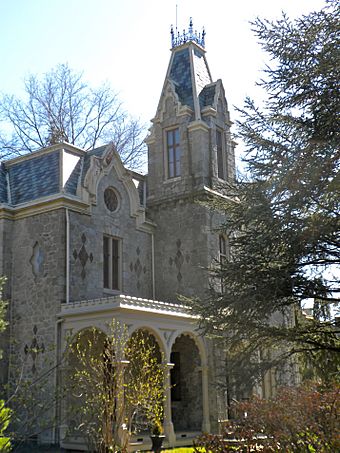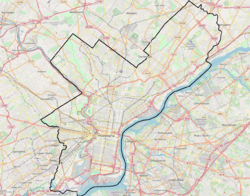Ebenezer Maxwell House facts for kids
|
Ebenezer Maxwell House
|
|
|
U.S. Historic district
Contributing property |
|
 |
|
| Location | 200 W. Tulpehocken St., Philadelphia, Pennsylvania |
|---|---|
| Area | less than one acre |
| Built | 1859 |
| Architectural style | Victorian Eclectic |
| NRHP reference No. | 71000728 |
Quick facts for kids Significant dates |
|
| Added to NRHP | February 24, 1971 |
The Ebenezer Maxwell House, also known as the Ebenezer Maxwell Mansion, is a historic house in the West Germantown area of Philadelphia, Pennsylvania. Today, it is a museum that shows what life was like in the Victorian era.
Contents
History of the Maxwell House
Building a Victorian Home
The Ebenezer Maxwell House was built in 1859. It cost $10,000, which was a very large amount of money back then! The house was built for Ebenezer Maxwell, who was a successful cloth merchant. He lived there with his family.
What the House Looks Like
The house is made of stone and has two-and-a-half stories. It also has a tall, three-story tower. The main roof is a special type called a mansard roof, which has four sloping sides. This roof is covered with slate tiles. The house also has three porches and four stone chimneys. Two architects, Joseph C. Hoxie and Samuel Sloan, are thought to have designed the house.
Changes Over Time
Over the years, the house has seen some changes. In 1965, the Germantown Historical Society helped restore the house. Later, in 1970, one of the porches was removed. In 1979 and 1980, a special cast-iron sidewalk was moved from another location and added to the back porch of the house.
A National Historic Place
Because of its history and unique design, the Ebenezer Maxwell House was added to the National Register of Historic Places in 1971. This means it is recognized as an important historical site in the United States. It is also part of the Tulpehocken Station Historic District, which is a neighborhood with many old and important buildings.
Visiting the House Museum
Today, the Ebenezer Maxwell House is open to the public as a house museum. This means it has been carefully restored to look just like it did during the Victorian era. Visitors can explore the rooms and see how people lived in the 1800s. The beautiful gardens around the house are also part of the museum experience. It's a great way to step back in time and learn about history!
Gallery
See also
 In Spanish: Casa Ebenezer Maxwell para niños
In Spanish: Casa Ebenezer Maxwell para niños





